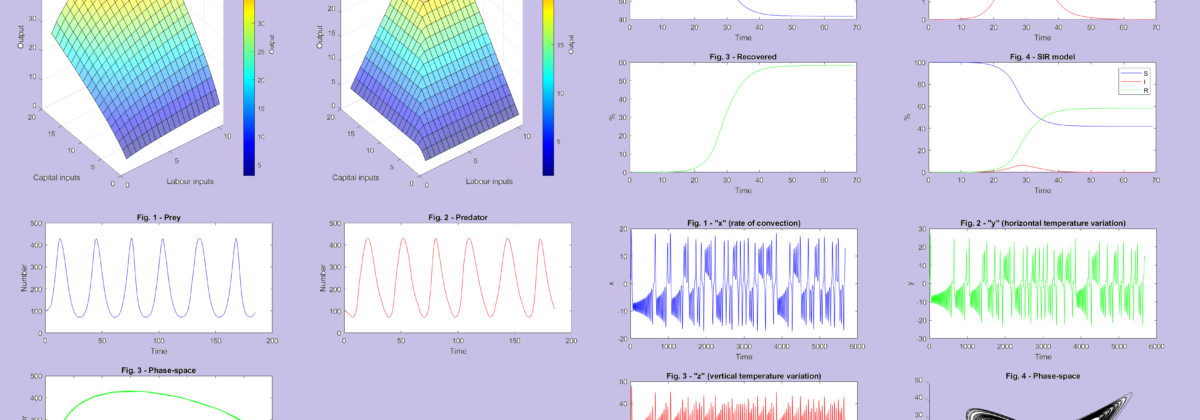I codici possono essere liberamente scaricati e utilizzati. Se li utilizzate per eventi pubblici o pubblicazioni, è gradita la citazione della fonte.
Attenzione: il materiale è disponibile solo in lingua inglese.
Video
Sono disponibili dei video-guida all’utilizzo dei modelli ai link seguenti:
- Tutorial 1: How to create a simple SFC model in R: First Part
- Tutorial 2: How to create a simple SFC model in R: Second Part
Per accedere, richiedete le password scrivendo a marco.veronese.passarella@gmail.com. I codici relativi ed altri codici possono essere scaricati dal mio archivio GitHub. NEW
Vedi anche il seminario di Gennaro Zezza su Applied Stock-Flow Consistent Modelling (YouTube)
R codes for selected SFC and AB toy models (see also my GitHub repository).
- Six lectures on SFC models, November-December 2023. NEW
- SIM model. This code replicates results in the book Monetary Economics: An Integrated Approach to Credit, Money, Income, Production and Wealth, by Wynne Godley and Marc Lavoie, chapter 3, figures 3.2 and 3.3. See also: Matlab version; Python version; EViews version (from Gennaro Zezza‘s website). If you would like to receive a Simulink version, just contact me.
- SIM model 2. This code replicates results in the book Monetary Economics: An Integrated Approach to Credit, Money, Income, Production and Wealth, by Wynne Godley and Marc Lavoie, chapter 3, figure 3.1.
- SIM micro model. This code replicates model SIM but using individual consumption functions.
- SIM SFCR model. This code replicates model SIM by using the SFCR package. It is an amended version of the original code developed by Joao Macalos.
- PC model. This code replicates results in the book Monetary Economics: An Integrated Approach to Credit, Money, Income, Production and Wealth, by Wynne Godley and Marc Lavoie, chapter 4, figures 4.3 and 4.4.
- EMP model (or PC BIMETS model). This code replicates and estimates model PC by using Eurostat data for Italy and the Bimets package. NEW
- PCEX2 model. This code replicates results in the book Monetary Economics: An Integrated Approach to Credit, Money, Income, Production and Wealth, by Wynne Godley and Marc Lavoie, chapter 4, figures 4.9 and 4.10.
- OPEN model. This code replicates results in the book Monetary Economics: An Integrated Approach to Credit, Money, Income, Production and Wealth, by Wynne Godley and Marc Lavoie, chapter 6, figures 6.8 to 6.11.
- OPENFLEX model. This code replicates results in the book Monetary Economics: An Integrated Approach to Credit, Money, Income, Production and Wealth, by Wynne Godley and Marc Lavoie, chapter 12.
- OPENSIME model. This code replicates the OPENSIME model presented and used in E. Carnevali, “A New, Simple SFC Open Economy Framework”, Review of Political Economy, 2021, DOI: https://doi.org/10.1080/09538259.2021.1899518
- BMW model. This code replicates results in the book Monetary Economics: An Integrated Approach to Credit, Money, Income, Production and Wealth, by Wynne Godley and Marc Lavoie, chapter 7, figures 7.1 to 7.4.
- DAFNIK model. This code was developed by Yanis Dafermos and Maria Nikolaidi. It allows creating a SFC model calibrated using data for the US economy
- AB SIMEX model. This code was developed by Alessandro Caiani. It allows creating a simple Agent-Based SFC model, building upon model SIM.
Other useful codes:
- HIA model. This code replicates results in the book Economics with Heterogeneous Interacting Agents, by Alessandro Caiani, Alberto Russo, Antonio Palestrini and Mauro Gallegati, chapter 2.2, figure 2.4.
- VAR model. This code allows creating a 3-variable VAR model as a reduced-form DSGE model. US data are used. EViews version, R version, data (xls), data (csv).
- Lotka-Volterra model. This code creates a prey-predator model. EViews version, R version.
- A simple input-output model, also calculating reproduction prices.
- LUBS1620 models. These R codes replicate the experiments conducted in my LUBS1620 lectures. PKE model, ME model, MAE model, PKE-SFC model.
- Solow model. This code replicates the dynamics of a Solow-like growth model.
- SIR model. This code replicates a simple Susceptible-Infected-Recovered model of virus spread, assuming a fixed population with only three compartments (susceptible, infected and removed).
- SIM interactive model with Shiny. This code replicates results in the book Monetary Economics: An Integrated Approach to Credit, Money, Income, Production and Wealth, by Wynne Godley and Marc Lavoie, chapter 3.
Models from my publications
Web resources for SFC modellers and other useful links:
- Quick guide to R commands: Base R cheat sheet
- Repository of SFC models: Zezza website
- SFC modelling step by step: Dafermos website
- R and Python SFC models: Jo Michell website
- SFC packages and other material: Godin website
- Everything on Agent-Based Computational Economics: Tesfatsion website
- JMAB simulation toolkit: Caiani website
- SFCR package: Macalos website
- Model simulations: Kohler website
- Interactive macro: Bramucci website
- Godley package: Gamrot website
- DIY Macroeconomic Model Simulation: Kohler and Prante website



